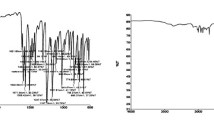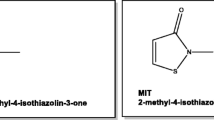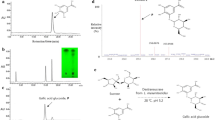Abstract
Hydroquinone (HQ) functions as a skin-whitening agent, but it has the potential to cause dermatitis. We synthesized a HQ fructoside (HQ-Fru) as a potential skin-whitening agent by reacting levansucrase from Leuconostoc mesenteroides with HQ as an acceptor and sucrose as a fructofuranose donor. The product was purified using 1-butanol partition and silica-gel column chromatography. The structure of the purified HQ-Fru was determined by 1H and 13C nuclear magnetic resonance, and the molecular ion of the product was observed at m/z 295 (C12 H16 O7 Na)+. The HQ-Fru was identified as 4-hydroxyphenyl-β-d-fructofuranoside. The optimum condition for HQ-Fru synthesis was determined using a response surface method (RSM), and the final optimum condition was 350 mM HQ, 115 mM sucrose, and 0.70 U/ml levansucrase, and the final HQ-Fru produced was 1.09 g/l. HQ-Fru showed anti-oxidation activities and inhibition against tyrosinase. The median inhibition concentration (IC50) of 1,1-diphenyl-2-picrylhydrazyl scavenging activity was 5.83 mM, showing higher antioxidant activity compared to β-arbutin (IC50 = 6.04 mM). The K i value of HQ-Fru (1.53 mM) against tyrosinase was smaller than that of β-arbutin (K i = 2.8 mM), indicating that it was 1.8-times better as an inhibitor. The inhibition of lipid peroxidation by HQ-Fru was 105.3% that of HQ (100%) and 118.9 times higher than that of β-arbutin (0.89% of HQ).



Similar content being viewed by others
References
Belghith H, Song KB, Kim CH, Rhee SK (1996) Optimal conditions for levan formation by an overexpressed recombinant levansucrase. Biotechnol Lett 18:467–472
Borek C (2001) Antioxidant health effects of aged garlic extract. J Nutr 131:1010S–1015S
Box GEP, Hunter WG, Hunter JS (1978) Statistics for experimenters. In: Box GEP, Hunter WG, Hunter JS (eds) An introduction to design, data analysis, and model building. Wiley, New York
De Roos NM, Katan MB (1988) Effects of probiotic bacteria on diarrhea, lipid metabolism. Am J Clin Nutr 71:405–411
Funayama M, Arakawa H, Yamamoto R, Nishino T, Shin T, Murao S (1995) Effects of alpha and beta arbutin on activity of tyrosinase from mushroom and mouse melanoma. Biosci Biotechnol Biochem 59:143–147
Hestrin S, Averini-Shapiro S, Ashner M (1943) The enzymatic production of levan. Biochem J 37:450–456
Hijum SAFT, Bonting K, Maarel MJEC, Dijkhuizen L (2001) Purification of a novel fructosyltransferase from Lactobacillus reuteri strain 121 and characterization of the levan produced. FEMS Microbiol 205:323–328
Jin YH, Lee SJ, Chung MH, Park JH, Cho TH, Lee SK (1999) Aloesin and arbutin inhibit tyrosinase activity in a synergistic manner via a different action mechanism. Arch Pharm Res 22:232–236
Jun SY, Park KM, Choi KW, Jang MK, Kang HY, Lee SH, Park KH, Cha J (2008) Inhibitory effects of arbutin-beta-glycosides synthesized from enzymatic transglycosylation for melanogenesis. Biotechnol Lett 30:743–748
Kang HK, Seo MY, Seo ES, Kim D, Chung SY, Kimura A, Day DF, Robyt JF (2005) Cloning and expression of levansucrase from Leuconostoc mesenteroides B-512 FMC in Escherichia coli. Biochim Biophys Acta 1727:5–15
Maeda K, Fukuda M (1991) Arbutin: mechanism of its depigmenting action in human melanocyte culture. Pharmacology 276:765–769
Moon YH, Lee JH, Ahn JS, Nam SH, Oh DK, Park DH, Chung HJ, Kang SS, Day DF, Kim D (2006) Synthesis, structure analyses, and characterization of novel epigallocatechin gallate (EGCG) glycosides using the glucansucrase from Leuconostoc mesenteroides B-1299CB. J Agric Food Chem 54:1230–1237
Mukerjea R, Kim D, Robyt JF (1996) Simplified and improved methylation analysis of saccharides, using a modified procedure and thin-layer chromatography. Carbohydr Res 292:11–20
Muller F (2000) The nature and mechanism of superoxide production by the electron transport chain: its relevance to aging. J Am Aging Assoc 23:227–253
Nakano H, Hamayasu K, Nakagawa K, Tabata A, Fujita K, Hara K, Kiso T, Murakami H, Kitahata S (2002) Transglycosylation of hydroquinone and epicatechin by β-fructofuranosidase from Arthrobacter sp. J Appl Glycosci 49:115–121
Nihei KI, Yamagiwa Y, Kamikawa T, Kubo I (2004) 2-Hydroxy-4-isopropyl benzaldehyde, a potent partial tyrosinase inhibitor. Bioorg Med Chem Lett 14:681–683
Parvez S, Kang M, Chun HS, Cho CW, Hong MC, Shin MK, Bae HS (2006) Survey and mechanism of skin depigmenting and lightening agents. Phytother Res 20:921–934
Pieroni A, Cassandra LQ, Villanelli ML, Mangino P, Sabbatini G, Santini L, Boccetti T, Profili M, Ciccioli T, Loredana GR, Antonini G, Girolamini C, Cecchi M, Tomasi M (2004) Ethnopharmacognostic survey on the natural ingredients used in folk cosmetics, cosmeceuticals and remedies for healing skin diseases in the inland Marches. J Ethnopharmacol 91:331–344
Riley PA (2003) Melanogenesis and Melanoma. Pigment Cell Res 16:548–552
Sreejayan N, Rao MNA (1997) Nitric oxide scavenging by curcuminoids. J Pharm Pharmacol 49:105–107
Sreejayan N, Rao MNA, Priyadarsini KI, Devasagayam TPA (1997) Inhibition of radiation-induced lipid peroxidation by curcumin. Int J Pharm 151:127–130
Sugimoto K, Nishimura T, Nomura K, Sugimoto K, Takashi K (2003) Syntheses of arbutin-α-glycosides and a comparison of their inhibitory effects with those of α-arbutin and arbutin in human tyrosinase. Chem Pharm Bull 51:798–801
Sugimoto K, Nomura K, Nishimura T, Kiso T, Sugimoto K, Takashi K (2005) Syntheses of arbutin-α-glycosides and their inhibitory effects on human tyrosinase. J Biosci Bioeng 99:272–276
Tomita K, Fukudo M, Kawasaki K (1990) Mechanism of arbutin inhibitory effect on melanogenesis and effect on the human skin with cosmetic use. Fragrance J 6:72–77
Yamamoto Y, Takashashi Y, Kawano M, Iizuka M, Matsumoto T, Saeki S, Yamaguchi H (2000) Hypercholesterolemic effects of levan in rat. In: Nishinari K (ed) Hydrocolloids (Part II),. Elsevier, New York, pp 399–400
Acknowledgments
This work was supported by 21C Frontier Microbial Genomics and the Applications Center Program. We thank the Korea Basic Science Institute Gwangju Branch for the NMR analysis.
Author information
Authors and Affiliations
Corresponding author
Rights and permissions
About this article
Cite this article
Kang, J., Kim, YM., Kim, N. et al. Synthesis and characterization of hydroquinone fructoside using Leuconostoc mesenteroides levansucrase. Appl Microbiol Biotechnol 83, 1009–1016 (2009). https://doi.org/10.1007/s00253-009-1936-5
Received:
Revised:
Accepted:
Published:
Issue Date:
DOI: https://doi.org/10.1007/s00253-009-1936-5




